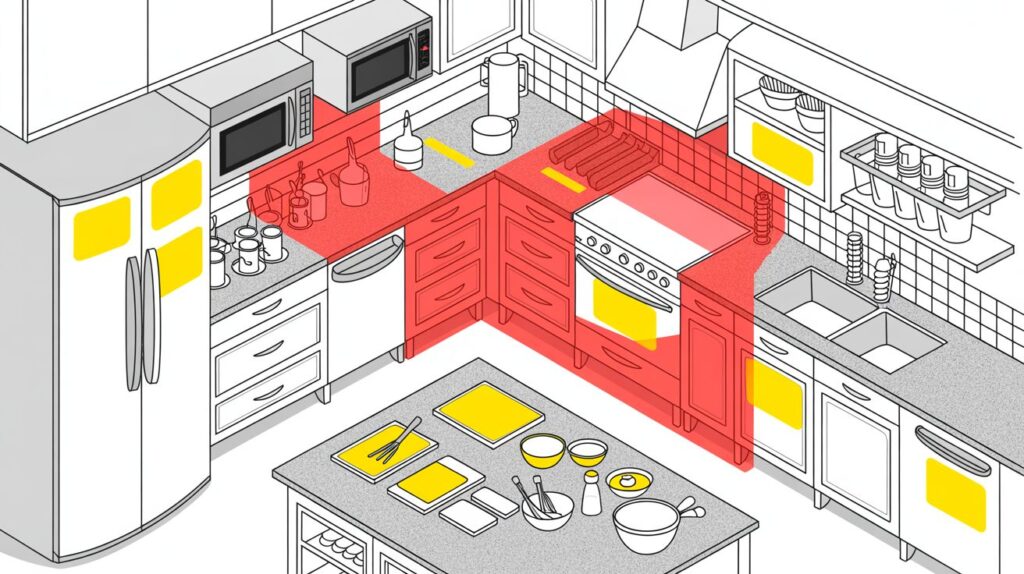I have been, or can be if you click on a link and make a purchase, compensated via a cash payment, gift, or something else of value for writing this post. As an Amazon Associate, I earn from qualifying purchases. Please read my full Affiliate Disclosure for more information.
To manage kitchen traffic flow for optimal efficiency, start with a practical walk-through to map current layout, bottlenecks, and peak times. Create clear work zones for prep, cooking, and cleanup, and place high-use appliances within a single pull radius of main prep areas. Establish efficient prep paths that minimize backtracking, and use visual cues and a shared log for concise handoffs. Regular audits keep zones tight, and staging near work zones reduces waits—keep improving, and you’ll access even faster results.
Key Takeaways
- Map task clusters and measure space to identify bottlenecks and optimize traffic routes for meal prep.
- Create dedicated prep, cook, and cleanup zones aligned with task flow to reduce backtracking.
- Position high-use appliances within a single pull radius of main prep areas to minimize trips.
- Implement visual communication cues, color codes, and a shared log for concise handoffs and updates.
- Stage tasks near zones, enforce clean storage and hot-surface safety zones, and routinely audit flow efficiency.
Assessing Your Kitchen Workspace

Evaluating your kitchen workspace starts with a practical walk-through: map out the current layout, noting where tasks cluster and where bottlenecks slow you down. You’ll identify task hotspots, measure counter and aisle widths, and log peak activity times to guide improvements. Focus on appliance placement to minimize back-and-forth trips and ensure safe, efficient access to heat sources, sinks, and prep zones. Assess storage organization for quick retrieval of commonly used tools and ingredients, reducing pauses during prep. Collect data, compare against ideal work-triangle concepts, and prioritize changes that yield measurable time savings and fewer interruptions.
Designing Clear Work Zones
Building on your workspace assessment, the next step is to design clear work zones that minimize movement and interruptions. You’ll define dedicated areas for prep, cooking, and cleanup, aligning tasks with your layout. Analyze task durations, peak times, and ergonomic needs to position tools where you reach them naturally. Prioritize logical sequencing to reduce backtracking and simplify handoffs between stations. Equipment placement matters: place high-use appliances within a single pull radius of primary prep zones. Storage solutions should keep seldom-used items out of the main flow yet accessible for quick retrieval. Regular quick audits ensure zones stay organized and efficient.
Establishing Efficient Prep Paths
Establishing efficient prep paths starts with mapping your tasks from the moment ingredients enter the kitchen to their first use, then trimming any detours that slow you down. You’ll analyze flow data, group steps by proximity, and identify high-traffic chokepoints. Prioritize streamlined routes that minimize back-and-forth and maximize continuous prep. Focus on ingredient placement to reduce reach time and cross-contamination risk, arranging items by prep sequence and perishability. Guarantee equipment accessibility, so essential tools are within arm’s reach and clearly labeled. Document changes, measure impact, and iterate for steady gains in speed, accuracy, and kitchen morale. Your prep path should be simple, repeatable, and scalable.
Implementing Communication Protocols
Effective communication drives consistency in a busy kitchen, so you should establish clear protocols for when to speak up, who communicates what, and how information is documented. You’ll implement standardized signals and concise handoffs to reduce confusion. Use silent communication where appropriate, like pre-agreed visual cues and color codes, to speed handovers without breaking flow. Document key updates in a shared log, with timestamps and roles. Train staff on cue recognition, ensuring everyone knows escalation paths for safety issues. Regular briefings reveal data-driven improvements, tracking delays, and bottlenecks, so you continuously refine protocols for smoother, safer meal prep.
Staging, Flow, and Safety Practices
Staging, flow, and safety practices are essential to keep the line moving smoothly while protecting staff. You’ll stage tasks near work zones to minimize walking, reduce cross-traffic, and prevent bottlenecks. Flow should follow a logical sequence: receiving, prep, cooking, and plating, with clear path boundaries and color-coded zones. Safety includes knock-down zones for hot surfaces, visible distance markers, and a buddy system during high-risk steps. Track storage solutions to ensure items are retrievable without double handling, and enforce cleaning routines to prevent-slip hazards and contamination. Regular audits quantify improvements, guiding training and continuous refinement for consistent throughput.
Conclusion
You’ll finish faster by mapping your space and sticking to it. Assess current workflow, then design clear zones for prep, cooking, and cleanup, minimizing back-and-forth. Establish concise prep paths that reduce crowding and collisions, backed by data like peak times and task durations. Institute simple, consistent communication so teammates anticipate moves. Stage ingredients before need, monitor flow, and adjust for safety. With proactive planning and ongoing measurement, kitchen throughput improves and meal prep stays predictable and efficient.

Leave a Reply